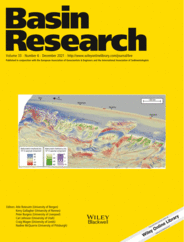
Full text loading...
Petroleum system modelling showing present‐day maturity (%Ro) of the Vaca Muerta Formation from from the Agrio Fold and Thrust Belt (west) to the NE Platform (east). The increase in TOC0 values from east to west is associated with thickening of the unit, which suggests the potential larger volumes of generated hydrocarbons for the same thermal gradient. The E–W thermal maturity trend is consistent with the decrease in HI and increase in TR values to the west, indicating that in conjunction with increased TOC0, organic pores represent the main control on total porosity in organic‐rich intervals of the unit.
The Vaca Muerta Formation (Tithonian–early Valanginian) is the main source rock in the Neuquén Basin and the most important unconventional shale resource in South America. In the present study, organic geochemistry, electron microscopy and basin and petroleum system modelling (BPSM) were combined to evaluate source rock properties and related processes along a transect from the early oil (east) to the dry gas (west) window. The unit is characterized by high present‐day (1%–8% average) and original (2%–16% average) total organic carbon contents, which increase towards the base of the unit and basinal (west) settings. Scanning electron microscopy shows that organic pores derived from the transformation of type II kerogen. Isolated bubble pores are typical of the oil window, whereas bubble and densely distributed spongy pores occur in the gas stage, indicating that the maturity gradient exerts strong control on organic porosity. Organic geochemistry, pressure and porosity data were incorporated into a 2D basin petroleum system model that includes the sequential restoration of tectonic events and calculation of compaction trends, kerogen transformation, hydrocarbon generation and estimation of pore pressure through geologic time. The W–E regional model extends from the Agrio Fold and Thrust Belts to the basin border and allows us to evaluate the relationship between thermal maturity and timing of hydrocarbon generation from highly deformed (west) to undeformed (east) regions. Modelling results show a clear decrease in maturity and organic matter (OM) transformation towards the eastern basin margin. Maximum hydrocarbon generation occurred in the inner sectors of the belt, at ca. 120 Ma; long before the first Andean compression phase, which started during the Late Cretaceous (ca. 70 Ma). Miocene compression (15–7 Ma) promoted tectonic uplift of the inner and outer sectors of the belt associated with a reduction in thermal stress and kerogen cracking, as well as massive loss of retained fluids and a decrease in pore pressure. The OM transformation impacted (a) the magnitude of effective porosity associated with organic porosity development, and (b) the magnitude and distribution of pore pressure within the unit controlled by hydrocarbon generation and compaction disequilibrium. BPSM shows a progressive increase in effective porosity from the top to the base and towards the west region related to the original organic carbon content and maturity increasing along the same trend. Overpressure intervals with high organic carbon contents are the most prone to develop organic pores. The latter represent favourable sites for the storage of hydrocarbons in the Vaca Muerta Formation.
]
Article metrics loading...

Full text loading...
References


Data & Media loading...

